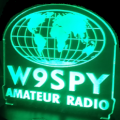The KiwiSDR 2 online store is open for orders! Please visit kiwisdr.nz
Please visit kiwisdr.com (documentation) and kiwisdr.nz (online store)
Question re exactly what the GPS function is for
Hello Everyone:
I just assembled and now have running my new KiwiSDR, along with a W6LVP mag loop antenna. But I have a question about the function of the GPS in terms of exactly what its central function is to the the overall "wellness" of the SDR itself.
I've had a few issues with getting the GPS to acquire more than just two "good" signals and I've made a few tweaks that have improved things (attached the antenna fob to a ground plane, which helped). I've also got a new GPS antenna on the way.
However, even with the GPS not functioning at its full, intended capacity, I note that I'm actually getting really good, clear signals while dialing through the bands on known frequencies, such things as WWV and other established signals. So, even with the GPS not functioning as well as it could be, my SDR seems to be working well enough.
So, to my question, exactly what is the function of the GPS mainly aimed at? Is it proper frequency calculation to remove any and all offset error? (I've had a couple of amateur radio pros have a look at my signals and they have noted that some of the signals are off by a few 100 Hz. They determined this while monitoring WSPR and FT8 amateur radio digital mode signals, which all work on specific frequencies and are calibrated to computer time clocks).
Thank you.
I just assembled and now have running my new KiwiSDR, along with a W6LVP mag loop antenna. But I have a question about the function of the GPS in terms of exactly what its central function is to the the overall "wellness" of the SDR itself.
I've had a few issues with getting the GPS to acquire more than just two "good" signals and I've made a few tweaks that have improved things (attached the antenna fob to a ground plane, which helped). I've also got a new GPS antenna on the way.
However, even with the GPS not functioning at its full, intended capacity, I note that I'm actually getting really good, clear signals while dialing through the bands on known frequencies, such things as WWV and other established signals. So, even with the GPS not functioning as well as it could be, my SDR seems to be working well enough.
So, to my question, exactly what is the function of the GPS mainly aimed at? Is it proper frequency calculation to remove any and all offset error? (I've had a couple of amateur radio pros have a look at my signals and they have noted that some of the signals are off by a few 100 Hz. They determined this while monitoring WSPR and FT8 amateur radio digital mode signals, which all work on specific frequencies and are calibrated to computer time clocks).
Thank you.

Comments
As you point out there is always some frequency offset that needs to be compensated for if you want the Kiwi frequency scale to be 100% accurate. How much offset is present is usually a function of how good the main oscillator is and how much temperature swing the room has where the Kiwi is located. During design we decided to trade off using a less expensive oscillator with greater offset variation (manufacturing tolerance and temperature coefficient) for the small cost of adding the GPS front end (front end chip, SMA connector, shield can, a few discrete components). And then use the GPS to compensate for the offset of the oscillator. The other pieces needed for the software-defined GPS came for free because we had available space in the FPGA for the required firmware (in fact the Kiwi shares several parts of the GPS firmware: the FPGA embedded processor and SPI interface).
Without GPS compensation enabled you can see exactly how much offset you have by following the manual calibration procedure described here: http://kiwisdr.com/quickstart/index.html#id-cal
But the real advantage in having on-board GPS is that you can now add very accurate timestamps to the IQ samples that external software can stream from the Kiwi. This allows some very interesting cooperative measurements to be made using multiple Kiwis where the IQ samples must be aligned via the timestamps. The most famous example of course is Christoph's TDoA direction finding algorithms to which we (and others) have added a user interface (see TDoA entry in Kiwi extension menu and the various write-ups about TDoA on the kiwisdr.com homepage).
Thanks for answering my question.